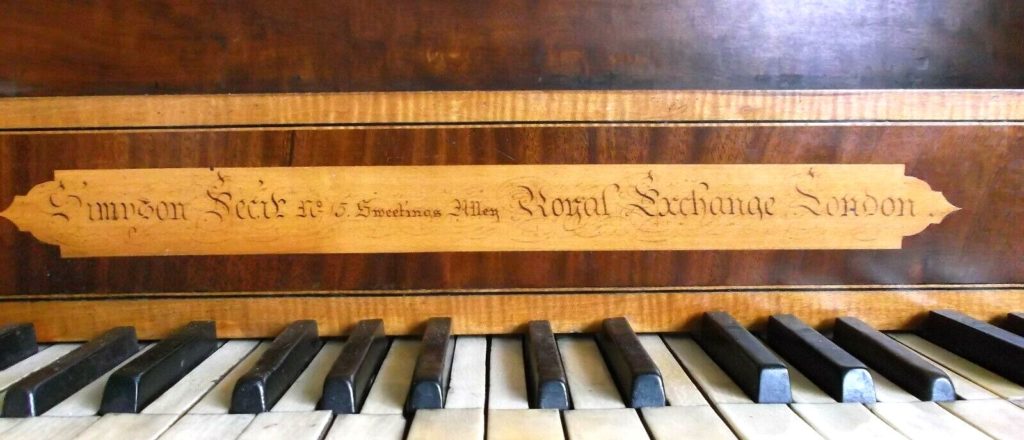Gabriel Buntebart for James & John Simpson 1779
Description

| Date: | 1779 |
| Origin: | London |
| Serialnumber: | --- |
In the late eighteenth century in England, many instrument makers also worked as suppliers to music shops, which themselves did not produce instruments, but only sold them. A prominent example is the company Longman & Broderip, for which Christopher Ganer or Johannes Zumpe worked. An example of this is the instrument by Johannes Zumpe made in 1769 in the Eric Feller Collection (click here for further information – Johannes Zumpe for Longman and Lukey & Co. 1769).
This interesting instrument shows the relationship between the renowned instrument maker Gabriel Buntebart and the James & John Simpson company, who in the late 18th century in London acted with musical instruments and various instruments. So far only three other instruments have been survived from Simpson.
The case is made in mahogany and has no inlays. To the left of the keyboard are three hand stops for dampers and lute. The instrument has a simple English single action and is double strung. It rests on the original trestle stand. The keys are made of ivory and ebony. The nameboard bears the inscription:
“Simpson Fecit No 15 Sweetings Alley Royal Exchange London”
Furthermore, there are several handwritten signatures inside, which appeared during the cleaning and examination. A signature behind the nameboard and in the inner case bears the inscription:
“Gabriel Buntebart 1779”
and shows the maker and the year of manufacture. Furthermore, several signatures show that the instrument was around 1840 in the possession of Lady Joyce and was repaired. Further research is ongoing. The instrument has a small size and is simple but very well made.
In 1732 John Simpson founded a music store and sold sheet music and instruments (mainly violins and flutes). These instruments were subcontracted to various instrument makers and were sold under their own name “Simpson.”
After John Simpson’s death (around 1750/51) his wife Ann took over the business together with her new husband John Cox, whom she married in 1751. John Cox was also a music publisher and had his own business. Furthermore he was a singer and was a regular member of the G. F. Handel choir. He sang the Habdonah in Handel’s oratorio Esther in 1751. He also sang in Handel’s Messiah in the performances of 1754, 1758 and 1759 (see: Philip H. Highfill, Jr., Kalman A. Burnim, Edward A. Langhans: A Biographical Dictionary of Actors, Actresses, Musicians, Dancers, Managers, and Other Stage Personnel in London, 1660 – 1800).
Later Ann’s son James joins the company and then from 1767 his son John. Old records indicate that in 1769 the company’s entire inventory was insured for £ 1,000, which was one of the highest sums insured at that time. This shows that the business flourished (see: David Barnett: The structure of Industry in London 1775 – 1825). The business was continued until 1795.
Gabriel Buntebart was one of the most renowned instrument makers in the late 18th century in England. He came 1761 during the Seven Years’ War (1756 – 1763) from Strelitz (Mecklenburg Germany) to England. The hope for a better life and a regular income was the motivation to immigrate. He was in business relationship with Johann Christian Bach (1735 – 1782). Together with Johannes Zumpe (1726 – 1790) he built from 1769 to 24 September 1778 instruments. After the end of this partnership Buntebart entered into a new partnership with Christopher Sievers from 1783 to 1792, while Zumpe entered into a partnership with the two brothers Frederick and Christian Schoene. An instrument from this period is also in the Eric Feller Collection (square piano by Schoene & Co. 1788). Gabriel Buntebart died in 1794.
This instrument, signed by James & John Simpson, was built by Buntebart in 1779, exactly one year after he ended his partnership with Johannes Zumpe. Interesting is another preserved instrument owned by David Hackett, which is also attributed to Gabriel Buntebart.
Other surviving instruments by James & John Simpson:
- 1775 square piano – John Hobsen, Wellesbourne England
- 1780 square piano – formerly in the Colt Collection, Bethersden England
- 1780/85 square piano – David Hackett, Chelveston England
| Length: | 133 cm |
| Width: | 51 cm |
| Height: | 19,5 cm |
| Circumference: | 5 octaves (FF – f3) |
| Mechanics: | single action with single dampers |
| Pedals: | 3 hand stops - divided dampers, lute |
| Signature: |
Simpson Fecit No 15 Sweetings Alley Royal Exchange London Gabriel Buntebart 1779 |

